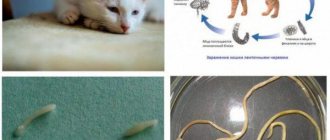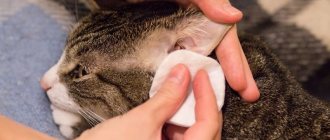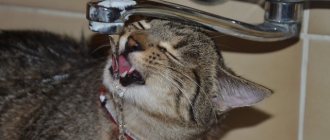- Why is my cat itching?
- Main symptoms
- Prevention
- What will the vet do?
Cat owners are well aware that their pets are prone to scratching behind their ears or licking their bellies.
They observe a similar picture several times a day and do not regard this behavior of the animal as abnormal. Indeed, cats love to wash themselves, but what to do if your pet itches very often for no apparent reason. If a cat constantly licks itself and the process of licking fur is accompanied by intense scratching of different parts of the body, then you should take a closer look at your pet. Perhaps the answer lies in simple things. The reason for this behavior of the animal can be several pathological conditions at once, which provoke the appearance of itching.
Diagnosis of the condition
An unpleasant sensation that causes a strong desire to scratch is itching. This condition in an animal is an obvious sign of skin damage. In veterinary medicine, there are 2 types of disorders:
- Localized type, when one or several places on the pet’s body begin to itch. Sometimes scratches appear only on the face, as well as on the neck and cheeks.
- Generalized type, which involves the appearance of sores on the entire body of the animal.
If you notice that your cat is itching a lot and drops of blood appear in the scratching areas, you need to contact a specialist at a veterinary clinic. To begin with, the pet is examined for the presence of blood-sucking parasites, which can cause severe stress in both couch potatoes and walking individuals. Scratch marks from bites are most often found on the chin, cheeks, neck, and tail. If fleas or ticks are not detected, then we are talking about other, more serious reasons.
After questioning the owner, the doctor will scrape the damaged area on the pet’s skin. Examination of the sample in the laboratory helps to identify the causative agent of the disease. Additional tests may also be ordered.
Once the exact disease is determined, the veterinarian prescribes treatment and gives additional recommendations on nutrition and care for the recovering patient.
Unfortunately, owners go to the veterinary clinic too late: when they discover severe wounds, bleeding scratches or bald patches on the pet’s body. This is the next stage of the pathology, which causes severe discomfort and can lead to severe infection. The duty of a good owner is to notice and respond to the problem in a timely manner.
Prevention measures
- Limit your indoor cat's contact with street animals. At the same time, do not deprive her of fresh air: you can let your pet out onto the balcony or into a fenced-in space, for example, in the country.
- Timely treat your pet against external (fleas, ticks) and internal (helminths) parasites.
- Inspect the animal's fur and skin.
- Provide a balanced diet and avoid consuming foods that cause allergic reactions.
- Cats feel the manifestation of love and care from humans. You should not allow your pet to experience stress. Any worries and neuroses are the first step towards the development of diseases.
- Regular visits to the veterinary clinic .
[custom_ads_shortcode1]
Causes of itching and scratching
Sometimes scratching in a cat may not be associated with diseases, but may be caused by seasonal factors. So, during spring and autumn molting, cats begin to itch and lick themselves more intensely. By doing this, they are trying to improve blood circulation and bring the coat into complete order.
You should be wary when a cat scratches the same place. He jumps up sharply (even if he was sleeping) and begins to furiously comb out something invisible to the eye. If you observe this behavior for several days, and hair has already begun to fall out at the site of the scratching, it’s time to go to the veterinary clinic so that they can determine one of the probable causes of the problem.
The appearance of worms
Even a domestic cat that does not go outside can become infected with helminths. Parasite eggs enter the body through raw meat, unwashed grass picked on the street by a caring owner, outdoor shoes and human clothing. When worms begin to actively reproduce, the following symptoms appear:
- Severe discomfort in the anal area. The mustachioed friend rubs against the carpet and licks the area too often.
- Disturbances in the gastrointestinal tract, difficulty with bowel movements.
- Loss of the beautiful natural shine and silkiness of the coat. Severe peeling appears on the skin.
- Discharge and inflammation of the eyes.
- Obvious changes in the behavior of the mustachioed friend. He becomes overly restless, or maybe, on the contrary, looks at everything with indifference.
- Lungworms and heartworms cause coughing and shortness of breath.
In this case, the cat is dewormed twice, with an interval of 10-14 days (details are indicated in the instructions for the drug). To avoid such problems in the future, make it a rule to carry out deworming quarterly.
Bacterial diseases
One of the most diagnosed bacterial diseases is pyoderma. This disease causes your pet to itch until it bleeds. The main cause of damage is long-term consumption of low-quality dry food, which contains few useful elements. Pyoderma is accompanied by the following symptoms:
- severe baldness;
- severe itching;
- skin peeling;
- scabs on the body;
- purulent inflammation with cloudy liquid.
Bacteria penetrate the epidermis and then go deep into the skin. This is especially true for short-haired or hairless breeds. Without prompt medical treatment, your pet's death is possible. Self-treatment of pyoderma is excluded.
Otitis externa
Infections of the ear canals provoke severe itching, forcing the mustachioed friend to shake his head and scratch his muzzle until it bleeds. Inflammation is quite dangerous to health, so treatment should not be delayed. In severe cases, surgery may be required. The most obvious signs of external otitis are:
- deterioration in behavior - excessive restlessness, unusual meowing;
- scratching the ears;
- frequent head shaking;
- painful sensations when pressing on the auricle.
Advanced cases are fraught with complications in the form of redness of the auricle, increased temperature, thickening and swelling of the inflamed organ. Purulent discharge is possible.
Otitis media is diagnosed and treated at a veterinary clinic - the doctor conducts tests and prescribes medications. Therapy takes up to several weeks.
Ringworm in a cat
Ringworm is a disease caused by a fungal infection. If previously lichen was considered incurable, now there are a large number of medications that relieve this problem.
It is very important to identify the pathology at an early stage so that the animal does not become a threat to surrounding family members or relatives, since lichen is a rather contagious ailment. If an animal has picked up a fungus, you can notice a number of characteristic features:
- baldness on the paws, ears, back;
- the appearance of bleeding wounds;
- formation of scabs on the body;
- change in character, lethargy, apathy;
- lack of appetite.
If signs are detected, the patient must be shown to a veterinarian. Only a specialist can make an accurate diagnosis. To do this, he will take tests and illuminate the patient’s body with an ultraviolet lamp - the fungal spores will phosphoresce. It is important to strictly follow your doctor’s instructions to speed up recovery and reduce the threat of infection. Self-medication for lichen is contraindicated.
Skin parasites
Cat scratching can be caused by different types of insects: lice, mites, coccidia, ear mites and fleas. Due to infection, the coat loses its shine and becomes very thin. The skin itself becomes very dry and flabby. The cat becomes restless and experiences sudden bouts of itching.
Even a cat that does not walk outside and does not interact with other animals cannot be protected from the appearance of parasites. Infection occurs through infected clothing or shoes of the owner and family members. As a result, the animal develops a desire to scratch itself, and hair falls out in certain areas of the body. The doctor prescribes solutions and ointments to the patient. They can reduce discomfort and reduce the parasite population.
Allergic reactions
Allergies are triggered by different types of food or chemicals. The nutritional cause of sores is associated with the animal eating harmful foods or low-quality industrial feed. Allergies can also occur when a cat’s diet changes.
When visiting the veterinarian, you need to remember what your pet has eaten over the past 7-10 days. You need to talk about changing food and treats from the master's table. The doctor does tests for different allergens, and then prescribes a neutral diet. Antihistamines and ointments are prescribed as medications. These products help reduce itching and reduce the number of sores on your mustachioed friend’s body.
Non-food allergies are even more troublesome because they can be caused by anything. To begin with, the owner should change the bowls, bedding or bed, and also prevent the pet’s body from coming into contact with things washed with synthetic detergents.
It is almost impossible to determine the cause of this pathology using tests. Ulcers with scabs do not allow you to get an accurate result, so most likely it will be a false positive. In addition, non-food allergies can be seasonal. For example, during the flowering period of different plants, a reaction to pollen begins, and during dry weather, symptoms to dust may occur.
The most effective thing to do is to show maximum attention and determine what exactly is bothering the cat. Only the owner can accurately notice all changes in the cat’s behavior when a suspected allergen appears/excludes.
Hormonal imbalances
Sometimes problems with the skin appear due to diseases associated with impaired hormone secretion. Improper functioning of the endocrine system provokes many symptoms, the appearance of which requires contacting a veterinary clinic. The most common ailments associated with hormonal imbalances are:
- Thyroid dysfunction, which causes tangled hair, flaking, severe itching and noticeable baldness.
- Cushing's syndrome, causing severe pain and partial hair loss on the sides and back. The skin becomes very dry and loses elasticity.
- Diabetes mellitus, which causes loss of shine and thinning of hair. The cat scratches its body until it bleeds and drinks a lot.
In a veterinary clinic, the doctor prescribes general tests of blood, urine, feces, and takes scrapings for laboratory tests. Only a thorough examination will help make an accurate diagnosis and prescribe the necessary medication.
Stress and mental disorders
In rare cases, if a specialist cannot confirm the above ailments, scratching is associated with certain mental disorders. The cat begins to lick itself vigorously, which provokes the appearance of wounds and ulcers. They form on the front and hind limbs, in the scapular region. The owner should pay attention to the fact that the cat has become nervous, aggressive, and continues to lick itself, despite the increasing pain. The wounds grow rapidly and become deeper, but the animal does not pay attention to this.
The doctor will recommend the use of sedative medications. The course of medication should cause the ulcers to dry out. This occurs due to the cessation of active licking and a decrease in overall tension.
The cause of a mental disorder can be anything - from moving to a new house to a banal fright. It is important to create a calm atmosphere around and be attentive to the cat.
Skin diseases
As a rule, they are all infectious in nature and occur after a pet comes into contact with an infected object. Sometimes it is enough for a cat to go outside just once to pick up some kind of infection. Often, diseases such as pyodermatitis, cheyletiellosis, demodicosis, and scabies occur.
They are also caused by mites that parasitize the upper and deep layers of the skin. Severe itching in the first stages very quickly develops into general skin damage and baldness.
If a cat's skin problems are detected, the cat owner needs to thoroughly wash their hands with soap and maintain personal hygiene, since many viruses and bacteria can be transmitted to human hands.
[custom_ads_shortcode1]
Treating scratches at home
When it is not possible to quickly contact a veterinarian, the pet still needs help. If you do nothing, the situation begins to worsen, and the sores become very painful. You can understand that the pathology is becoming more complicated by the cat’s reaction - he tries to hide and does not allow the sores to be examined.
Another dangerous factor is the risk of infection of the sores. This leads to irreversible consequences and even death. This happens due to ignoring the pathology, as well as improper treatment. Therefore, if you find a sore or scratch, you should not immediately smear it with human products - it is better to observe your pet and then consult a doctor.
Sometimes the owner cannot quickly take his mustachioed friend to the hospital, but the doctor is able to prescribe medications over the phone. This will help somewhat reduce discomfort and remove the threat of the disease spreading throughout the body. It is important to remember that this does not cancel a visit to the clinic, but only provides a temporary relief effect.
The formation of abscesses and abscesses requires surgical intervention. The doctor promptly removes pus from deep wounds and washes them. Non-steroidal anti-inflammatory drugs are then prescribed to restore the patient's weak immune system.
If the inflammation is not very extensive and does not provoke severe pain, then treatment at home is more like preventive measures. If there is no infection, the wounds begin to heal within a couple of days. To disinfect and relieve discomfort, sores are wiped with calendula tincture or hydrogen peroxide. You should not use alcohol solutions, because they will cause even more harm to the cat’s skin. It is best to buy a herbal mixture at the pharmacy and prepare the infusion yourself according to the instructions.
Veterinarian advice
It is no secret that many parasites and viruses are transmitted from one animal to another, through the hands of people, but you should not be afraid and limit the freedom of a cat. Of course, there is no need to throw your pet into a pack of stray cats, but letting it out for a walk on the balcony or in the country is quite possible. Like any animal, cats also need fresh air and sun. It is enough just to keep the animal clean and carry out timely antiparasitic treatment.
Do not forget about a proper and balanced diet, which is also the key to your pet’s health. If he has a strong immune system, then no infection will be scary to him. Do not feed prohibited foods, sweets, salty and smoked foods.
All this can cause or provoke the occurrence of food allergies. Pay attention to when your pet licks.
And finally, the last piece of advice is love and affection. Remember that your cat is a living creature that needs your care and attention. A change of owner or a change in your behavior can cause stress in your pet. And stress, as you know, is the first step to illness. If you want to pet an animal, but it is nervous and wags its tail, it is better to leave it alone, do not squeeze or pick it up without the desire of the pet itself. Remember that he also has the right to peace and rest.
Sorry, there are no surveys available at this time.
[custom_ads_shortcode1]
What to do if treatment is unsuccessful?
With correctly prescribed therapy, the effect is noticeable from the first days: the animal itches less and the ulcers begin to dry out. If there is no improvement within 5-7 days, you should definitely visit a veterinary clinic.
Even if the veterinarian prescribed the drugs, but there is no result, contact us again. It also happens that an examination by another doctor or in another veterinary clinic helps.
The main thing is not to let things take their course and achieve improvements in the cat’s condition. Otherwise, you will have to treat not only the root cause, but also secondary infections.
Psychogenic factors
Cat owners underestimate the potential psychogenic causes of itching in an animal. The latter appear during periods of severe stress, for example, in the absence of the possibility of mating. In this case, the pet may not only constantly itch, but also mark its territory, behave aggressively, refuse to eat food, and tear furniture with its claws.
There are several ways to solve the problem:
- Organization of mating;
- Castration of an animal;
- Using special sedatives for cats.
Why you can't stop itching
If you have not yet visited the veterinarian, you should not smear the sores with anything at all - this will distort the results of scrapings and tests, which will complicate the diagnosis. You should not immediately offer your animal antihistamines - firstly, you may not guess the dosage, and secondly, the blood test will be invalid.
Once the veterinarian has prescribed medications and ointments, there is no need to relieve itching - most medications already contain substances that reduce discomfort.
Finally, anti-itch medications in humans can cause allergies in cats, which will only make the problem worse.
Inflammatory processes that cause cats to itch
An obvious pathological factor that provokes constant itching of the skin in an animal is an active inflammatory process. It can be both local and systemic. The most well-known diseases in cats accompanied by an inflammatory process:
- Otitis. If this disease is present, the cat constantly scratches its ears and is very irritable because it suffers from severe pain. The solution to the problem will be the use of drugs that reduce the intensity of the inflammatory process in the designated location;
- Pyoderma. Pyoderma in animals is manifested by purulent inflammation of the skin provoked by coccal bacteria. The cat's epithelium is deeply affected and cannot be treated with local remedies: antibacterial therapy is required under the mandatory supervision of a veterinarian;
- Secondary bacterial infections. They occur after insufficient aseptic treatment of wounds, cuts, and surgical sutures. Treated with broad spectrum antibiotics.
Hormonal disorders
Systemic pathological processes leading to severe hormonal disorders negatively affect the entire body of a pet. Typical problems:
- Diabetes. A severe endocrine disease caused by relative or absolute insulin deficiency due to a number of reasons. At the present stage of development of veterinary medicine, it cannot be completely cured. A cat with diabetes develops bald patches, a sharp change in body weight (usually upward), the quality of the coat deteriorates, and the elasticity of the skin is lost. It is possible to alleviate the condition of a pet only with a special diet, as well as the use of medications on an ongoing basis;
- Cushing's syndrome. A rare cause of itchy skin observed in older cats. It is an extensive pathological symptom complex that develops against the background of excessive synthesis of hormones produced by the adrenal cortex. Complete relief from the problem is only possible through surgery and in situations where the syndrome is caused by tumors;
- Thyroid gland dysfunction. Depending on the type of pathological process (insufficient or excessive secretion of thyroid hormones), the cat may experience severe itching of the skin, partial or complete baldness, tangled hair, and other external negative symptoms.
Treatment of hormonal disorders in a pet is possible only under the supervision of a veterinarian.











